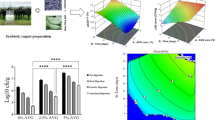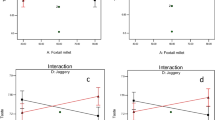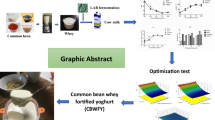Abstract
This study aimed to optimize the processing of probiotic yogurt supplemented with cumin essential oil (CEO), vitamin C, D3 (Vit D), and reduction of fermentation time using response surface methodology as a new functional food for diabetics with desirable sensory properties. The central composite design (CCD) was used to analyze the effect of these independent variables on the growth of the Lactobacillus plantarum A7 (LA7), starter culture, and overall acceptability. Differences between treatments were analyzed. The data were evaluated by analysis of variance at the significance level of 0.05. The effective concentration of CEO and fermentation time had the significant effect on the Lactobacillus plantarum A7 (LA7) number. Variance analysis and three-dimensional graphs show that almost the only effective factor on the overall acceptability of probiotic yogurt containing essential oil and vitamin D3 was CEO. According to the obtained data from the analysis, the optimal amount of independent variables for probiotic yogurt formulation such as CEO, D3, and fermentation time was 0.02% (v/v), 400 IU, and 9 h, respectively. This functional product can be considered an efficient food to reduce or eliminate the complications of diabetes.




Similar content being viewed by others
Data Availability
Data is available upon reasonable request from corresponding author.
References
Babashahi M, Mirlohi M, Ghiasvand R, Torki-Baghbadorani S (2016) Evaluation of response surface methodology to predict optimum growth conditions for Lactobacillus plantarum A7 (KC 355240) in probiotic soy milk containing essential oil of Cuminum cyminum. Recent Pat Food Nutr Agric 8(2):132–137
Plasek B, Lakner Z, Kasza G, Temesi Á (2020) Consumer evaluation of the role of functional food products in disease prevention and the characteristics of target groups. Nutrients 12(1):69
Mousavi M, Heshmati A, Garmakhany AD, Vahidinia A, Taheri M (2019) Optimization of the viability of Lactobacillus acidophilus and physico-chemical, textural and sensorial characteristics of flaxseed-enriched stirred probiotic yogurt by using response surface methodology. LWT 102:80–88
Mohamadshahi M, Veissi M, Haidari F, Javid AZ, Mohammadi F, Shirbeigi E (2014) Effects of probiotic yogurt consumption on lipid profile in type 2 diabetic patients: a randomized controlled clinical trial. J Res Med Sci 19(6):531
Ejtahed H, Mohtadi-Nia J, Homayouni-Rad A, Niafar M, Asghari-Jafarabadi M, Mofid V et al (2011) Effect of probiotic yogurt containing Lactobacillus acidophilus and Bifidobacterium lactis on lipid profile in individuals with type 2 diabetes mellitus. J Dairy Sci 94(7):3288–3294
Bayat A, Azizi-Soleiman F, Heidari-Beni M, Feizi A, Iraj B, Ghiasvand R et al (2016) Effect of cucurbita ficifolia and probiotic yogurt consumption on blood glucose, lipid profile, and inflammatory marker in type 2 diabetes. Int J Prev Med 7
Ostadrahimi A, Taghizadeh A, Mobasseri M, Farrin N, Payahoo L, Gheshlaghi ZB et al (2015) Effect of probiotic fermented milk (kefir) on glycemic control and lipid profile in type 2 diabetic patients: a randomized double-blind placebo-controlled clinical trial. Iran J Public Health 44(2):228
Javaherian M, Bakhtiari R, Ajoudanifar H, Shokri S, Mirzaie A (2022) Microbiota, probiotics and common skin cancer: association and therapeutic application. J Biol Res-Boll Soc Ital Biol Sper
Sassi F, Tamone C, D’Amelio P (2018) Vitamin D: nutrient, hormone, and immunomodulator. Nutrients 10(11):1656
Bilezikian JP, Bikle D, Hewison M, Lazaretti-Castro M, Formenti AM, Gupta A et al (2020) Mechanisms in endocrinology: Vitamin D and COVID-19. Eur J Endocrinol 183(5):R133–R147
Grant WB, Boucher BJ (2019) A review of the potential benefits of increasing vitamin D status in Mongolian adults through food fortification and vitamin D supplementation. Nutrients 11(10):2452
Maurya VK, Bashir K, Aggarwal M (2020) Vitamin D microencapsulation and fortification: trends and technologies. J Steroid Biochem Mol Biol 196:105489
Salehi E, Hedayati N, Dolati S, Mirzaei R, Namdar A, Vojgani M (2015) The immunomodulatory effect 1, 25 (OH) 2 D3 on TLR 2 and TLR4 expression on monocytes of patients with type II diabetes mellitus. Arch Med Lab Sci 1(1)
Abed SS, Zaidan FH, Sathyamurthy B (2015) Biochemical marker analysis in diabetic patients
Li X, Liu Y, Zheng Y, Wang P, Zhang Y (2018) The effect of vitamin D supplementation on glycemic control in type 2 diabetes patients: a systematic review and meta-analysis. Nutrients 10(3):375
Nehra R (2019) Vitamin D levels in type 2 diabetics on insulin sensitizers vis a vis in newly diagnosed diabetics. Int J Clin Biochem Res 6(3):340–343
Hu Z, Chen J, Sun X, Wang L, Wang A (2019) Efficacy of vitamin D supplementation on glycemic control in type 2 diabetes patients: a meta-analysis of interventional studies. Medicine 98(14)
Szymczak-Pajor I, Śliwińska A (2019) Analysis of association between vitamin D deficiency and insulin resistance. Nutrients 11(4):794
Babashahi M, Mirlohi M, Ghiasvand R, Azadbakht L, Mosharaf L, Torki-Baghbadorani S (2020) Effects of probiotic soy milk fermented by Lactobacillus plantarum A7 (KC 355240) added with Cuminum Cyminum essential oil on fasting blood glucose levels, serum lipid profile and body weight in diabetic Wistar rats. Int J Prev Med 11
Jafari S, Sattari R, Ghavamzadeh S (2017) Evaluation the effect of 50 and 100 mg doses of Cuminum cyminum essential oil on glycemic indices, insulin resistance and serum inflammatory factors on patients with diabetes type II: a double-blind randomized placebo-controlled clinical trial. J Tradit Complement Med 7(3):332–338
Jafarnejad S, Tsang C, Taghizadeh M, Asemi Z, Keshavarz SA (2018) A meta-analysis of cumin (Cuminum cyminim L.) consumption on metabolic and anthropometric indices in overweight and type 2 diabetics. J Funct Foods. 44:313–321
Zhang D-W, Fu M, Gao S-H, Liu J-L (2013) Curcumin and diabetes: a systematic review. Evid Based Complement Alternat Med 2013
Tang C, Liu Y, Liu S, Yang C, Chen L, Tang F et al (2021) Curcumin and its analogs as potential epigenetic modulators: prevention of diabetes and its complications. Pharmacology: 1–13
Seida JC, Mitri J, Colmers IN, Majumdar SR, Davidson MB, Edwards AL et al (2014) Effect of vitamin D3 supplementation on improving glucose homeostasis and preventing diabetes: a systematic review and meta-analysis. J Clin Endocrinol Metab 99(10):3551–3560
Sengupta S, Bhowal J (2020) Optimization of ingredient and processing parameter for the production of Spirulina platensis incorporated soy yogurt using response surface methodology. J Microbiol Biotechnol Food Sci 9(6):1081–1085
Cruz A, Faria J, Walter E, Andrade R, Cavalcanti R, Oliveira C et al (2010) Processing optimization of probiotic yogurt containing glucose oxidase using response surface methodology. J Dairy Sci 93(11):5059–5068
Tamime AY, Robinson RK (2007) Tamime and Robinson's yoghurt: science and technology: Elsevier
Dahlan HA, Sani NA (2017) The interaction effect of mixing starter cultures on homemade natural yogurt’s pH and viscosity. Int J Food Stud 6(2)
Soni R, Jain NK, Shah V, Soni J, Suthar D, Gohel P (2020) Development of probiotic yogurt: effect of strain combination on nutritional, rheological, organoleptic and probiotic properties. J Food Sci Technol 57(6):2038–2050
Lazaridou A, Serafeimidou A, Biliaderis CG, Moschakis T, Tzanetakis N (2014) Structure development and acidification kinetics in fermented milk containing oat β-glucan, a yogurt culture and a probiotic strain. Food Hydrocolloids 39:204–214
Donkor O, Henriksson A, Vasiljevic T, Shah N (2006) Effect of acidification on the activity of probiotics in yoghurt during cold storage. Int Dairy J 16(10):1181–1189
Mårtensson O, Öste R, Holst O (2002) The effect of yoghurt culture on the survival of probiotic bacteria in oat-based, non-dairy products. Food Res Int 35(8):775–784
Mirlohi M, Soleimanian-Zad S, Dokhani S, Sheikh-Zeinodin M (2014) Microbial and physiochemical changes in yoghurts containing different Lactobacillus delbrueckii subsp bulgaricus strains in association with Lactobacillus plantarum as an adjunct culture. Int J Dairy Technol 67(2):246–254
Rybka S, Kailasapathy K (1996) Media for the enumeration of yoghurt bacteria. Int Dairy J 6(8–9):839–850
Shaghaghi M, Pourahmad R, Adeli HM (2013) Synbiotic yogurt production by using prebiotic compounds and probiotic lactobacilli. Int Res J Appl Basic Sci 5(7):839–846
Ilikkan Ö, Bağdat E, Yalçin D (2022) Evaluation of prebiotic, probiotic, and synbiotic potentials of microalgae. Food Health 8(2):161–171
Falah F, Vasiee A, Alizadeh Behbahani B, Tabatabaee Yazdi F, Mortazavi SA (2021) Optimization of gamma-aminobutyric acid production by Lactobacillus brevis PML1 in dairy sludge-based culture medium through response surface methodology. Food Sci Nutr 9(6):3317–3326
Falah F, Vasiee A, Yazdi FT, Behbahani BA (2021) Preparation and functional properties of synbiotic yogurt fermented with Lactobacillus brevis pml1 derived from a fermented cereal-dairy product. BioMed Res Int 2021
Stephenie W, Kabeir B, Shuhaimi M, Rosfarizan M, Yazid A (2007) Growth optimization of a probiotic candidate, Bifidobacterium pseudocatenulatum G4, in milk medium using response surface methodology. Biotechnol Bioprocess Eng 12(2):106–113
Bernat N, Cháfer M, González-Martínez C, Rodríguez-García J, Chiralt A (2015) Optimisation of oat milk formulation to obtain fermented derivatives by using probiotic Lactobacillus reuteri microorganisms. Food Sci Technol Int 21(2):145–157
Mahmoudi R (2013) Improvement the hygienic quality and organoleptic properties of bioyoghurt using Cuminum cyminum L. essential oil. J Agroalimentary Process Technol 19(4):405–412
Grujović MŽ, Mladenović KG, Semedo-Lemsaddek T, Laranjo M, Stefanović OD, Kocić-Tanackov SD (2022) Advantages and disadvantages of non-starter lactic acid bacteria from traditional fermented foods: potential use as starters or probiotics. Compr Rev Food Sci Food Saf 21(2):1537–1567
Jurášková D, Ribeiro SC, Silva CC (2022) Exopolysaccharides produced by lactic acid bacteria: From biosynthesis to health-promoting properties. Foods 11(2):156
Ruvalcaba-Gómez JM, Ruiz-Espinosa H, Méndez-Robles MD, Arteaga-Garibay RI, Anaya-Esparza LM, Villagrán Z et al (2022) Use of autochthonous lactic acid bacteria as starter culture of pasteurized milk adobera cheese. Fermentation 8(5):234
Kivanç M, Akgül A, Doǧan A (1991) Inhibitory and stimulatory effects of cumin, oregano and their essential oils on growth and acid production of Lactobacillus plantarum and Leuconostoc mesenteroides. Int J Food Microbiol 13(1):81–85
Seyedyousefi L, Golestan L, Kaboosi H (2013) Inhibitory effect of essential oil of Mentha spicata on the viability of probiotic bacteria in industrial liquid Kashk. J Innov Food Sci Technol 5(3):13–22
Sadeghi E, Akhondzadeh Basti A, Noori N, Khanjari A, Partovi R (2013) Effect of Cuminum cyminum L. essential oil and Lactobacillus acidophilus (a probiotic) on Staphylococcus aureus during the manufacture, ripening and storage of white brined cheese. J Food Process Preserv 37(5):449–455
Korbekandi H, Abedi D, Maracy M, Jalali M, Azarman N, Iravani S (2015) Evaluation of probiotic yoghurt produced by Lactobacillus paracasei ssp. tolerans. J Food Biosci Technol 5(1):37–44
Senadeera S, Prasanna P, Jayawardana N, Gunasekara D, Senadeera P, Chandrasekara A (2018) Antioxidant, physicochemical, microbiological, and sensory properties of probiotic yoghurt incorporated with various Annona species pulp. Heliyon 4(11):e00955
Ganesan B, Brothersen C, McMahon DJ (2011) Fortification of cheddar cheese with vitamin D does not alter cheese flavor perception. J Dairy Sci 94(7):3708–3714
Upreti P, Mistry V, Warthesen J (2002) Estimation and fortification of vitamin D3 in pasteurized process cheese. J Dairy Sci 85(12):3173–3181
Funding
This study was supported by the Food Safety Research Center of the Faculty of Nutrition and Food Sciences of Isfahan University of Medical Sciences In the form of a research project approved by code 394296.
Author information
Authors and Affiliations
Contributions
All authors contributed equally to the manuscript.
Corresponding authors
Ethics declarations
Ethical Approval
Ethical issues (including plagiarism, data fabrication, double publication) have been completely observed by the author.
Conflict of Interest
The authors declare no competing interests.
Additional information
Publisher's Note
Springer Nature remains neutral with regard to jurisdictional claims in published maps and institutional affiliations.
Rights and permissions
Springer Nature or its licensor (e.g. a society or other partner) holds exclusive rights to this article under a publishing agreement with the author(s) or other rightsholder(s); author self-archiving of the accepted manuscript version of this article is solely governed by the terms of such publishing agreement and applicable law.
About this article
Cite this article
Shojaeimeher, S., Babashahi, M., Shokri, S. et al. Optimizing the Production of Probiotic Yogurt as a New Functional Food for Diabetics with Favorable Sensory Properties Using the Response Surface Methodology. Probiotics & Antimicro. Prot. 16, 413–425 (2024). https://doi.org/10.1007/s12602-023-10051-z
Accepted:
Published:
Issue Date:
DOI: https://doi.org/10.1007/s12602-023-10051-z




